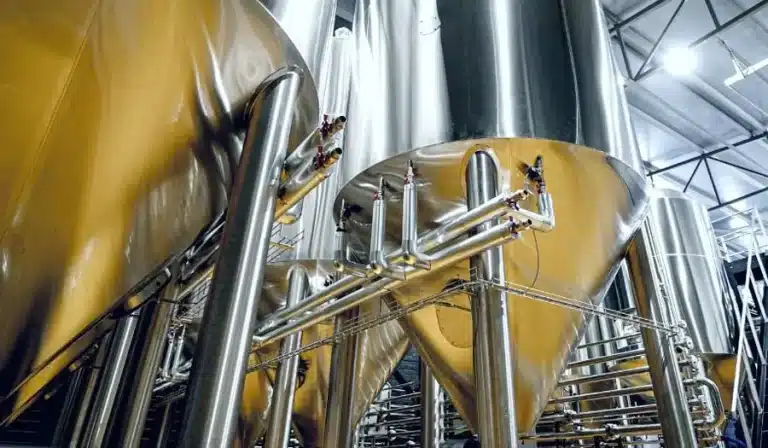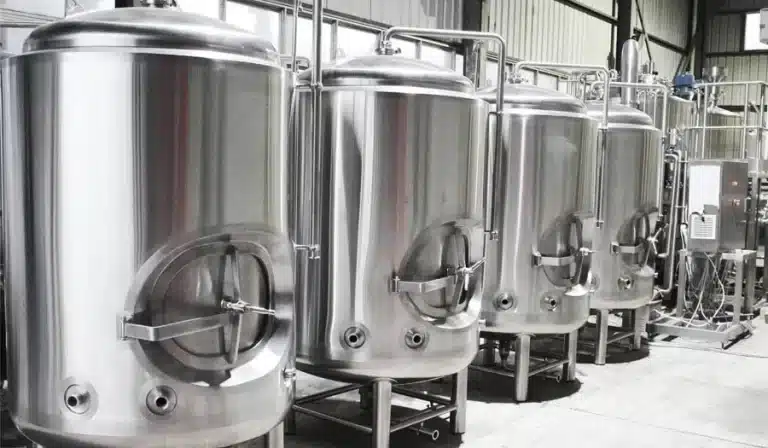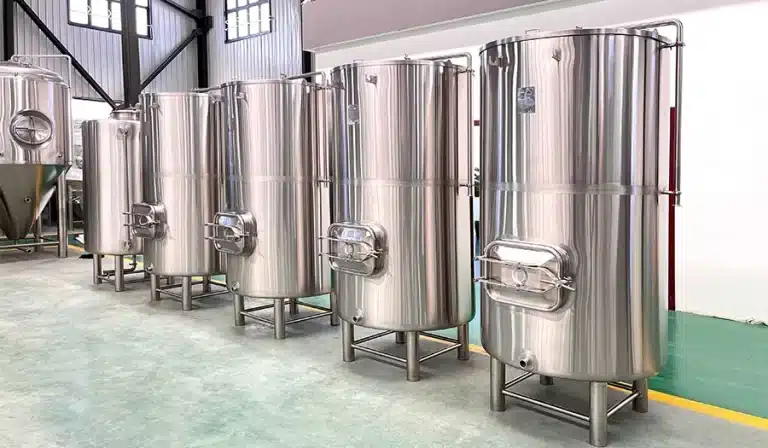In modern brewing technology, fermentation tanks and bright tanks are two important equipment that play a vital role in beer brewing. Although they may be similar in appearance, there are significant differences in their functions, working principles, and roles in the entire brewing process. Understanding the difference between the two will not only help us better understand the complexity of beer brewing but also help improve the quality of beer.
What is a fermentation tank?
De fermentatietank is one of the key equipment in the alcohol fermentation process. Its main function is to provide an alcohol environment for alcohol. The fermentation tank is able to convert the sugar in the malt into alcohol and fermentation agent, thereby completing the alcohol fermentation process. The fermentation tank is usually made of stainless steel. The material is corrosion-resistant and pressure-resistant and can withstand the gas pressure generated during the fermentation process. Its shape is usually a high and closed shape to ensure the closure and precise temperature control during the fermentation process.
While the main function of the fermentation tank is to provide a controlled environment for the fungal fermentation of wort, the style also plays a vital role in the subsequent steps of the brewing process, such as alcohol suitability and clarification.
The following are the types of fermentation tanks:
- Plastic fermentation tanks: economical and lightweight, but prone to scratches and potential contamination.
- Glass fermentation tanks: conducive to the visibility of the fermentation process, but fragile and bulky.
- Stainless steel fermentation tanks: durable, easy to clean, and ideal for professional brewing operations.

Advantages of Fermentation Tanks
- Precise temperature control: Temperature is a key factor in the fermentation process because the activity, fermentation rate, and flavor of the final fermentation are closely related to temperature. Fermentation tanks are usually equipped with efficient temperature control systems that can accurately control and maintain the temperature of the fermentation environment to ensure that the yeast actively works within the optimal temperature range.
- Control gas emission and pressure management: During the fermentation process, yeast converts sugars into alcohol while producing a large amount of high-pressure (CO2) gas. Fermentation tanks are equipped with exhaust systems and pressure regulators to effectively manage the release of gas in the tank.
- Sanitary and safe: Stainless steel is a very hygienic material and is the best choice for fermentation tanks. The smooth, non-porous surface of stainless steel prevents the accumulation of bacteria and other contaminants, ensuring that the fermentation tank remains clean and safe to use. Stainless steel fermentation tanks are also safe for food and beverages.
- Versatility: Another benefit of stainless steel fermentation tanks is their versatility and adaptability. These tanks can be used in a variety of fermentation processes, including the production of beer, wine, cider, kombucha, etc. They can also be customized according to the specific needs of each application and provide options such as temperature control, pressure release valves, and stirring systems.
- Reduced risk of contamination: When beer is taken out of the tank, it is exposed to the air, resulting in dissolved oxygen. In addition, the beer may also be exposed to other contaminants such as microorganisms. Although these microorganisms are usually not fatal, they can cause the beer to have off-flavors. Using a fermentation tank can reduce this risk of contamination.
What is a Bright Tank?
A Bright Tank is a stainless steel container used to carbonate and store beer. Bright Tanks are also known as service tanks, clear tanks, opslagtanks, or secondary fermentation tanks. These tanks are usually pressure-rated and can be equipped with accessories that allow for safe pressure transfer.
The main function of a Bright Tank is to complete the post-fermentation stage of beer, and it plays a key role in the beer brewing process. Bright Tanks feature a very simple flat-bottomed cylindrical design. A flat bottom is not as well suited to the fermentation process as the conical bottom of a one-piece tank, but Bright Tanks are still very suitable for storing maturing beer or holding beer while it awaits packaging.
Bright Tank Features
Carbonation Control
Another notable feature of the bright tank is that it allows for precise control of the carbonation of the beer. Carbonation is an important factor in the flavor and taste of beer, directly affecting the perceived bubbles and perception of the beer. In the bright tank, the brewer can achieve this through natural carbonation and forced carbonation. The bright tank is therefore able to provide more flexibility and precision to achieve the ideal bubble perception of the beer.
Maturation and Optimized Taste
The bright tank provides an additional maturation stage for the beer, which is essential for optimizing the flavor and stability of the beer. After fermentation, there may still be some unconsumed yeast, proteins, and other compounds in the beer, which may be further “matured” by standing in the sober tank, removing these residues, so that the beer has a smooth and rich taste.
Storage and Stability
In this case, the heldere tank is not only used for some formulation and carbonation but also for the storage of beer. It provides a stable environment for the beer, allowing it to be kept under ideal temperature and pressure conditions until packaging and distribution. This process helps to improve the stability and quality of the beer and avoid oxidation or other quality issues.
Suitable for different varieties of beer
The bright tank is suitable for a wide range of beer types and is not limited to a specific flavor or alcohol concentration. Whether it is a light lager, a strong IPA, or a complex Belgian late beer, the best results can be obtained by adjusting the treatment of the bright tank, such as carbonation and maturation time. This makes the bright tank a very flexible and versatile equipment in beer production.

Hoe werken heldere tanks?
Bright tanks are often used in commercial breweries because they offer many advantages over other types of beer storage containers. For example, because bright tanks are pressurized, they can be used to force-carbonate beer, a faster and more efficient method of carbonation than natural carbonation that relies on yeast activity. Additionally, because bright tanks are typically made of stainless steel, they do not absorb the flavors or odors of the beer being stored. This means that the beer that goes into a bright tank will taste the same as the beer that comes out of it.
How to choose between fermentation tanks and bright tanks?
For small breweries or brewpubs, fermentation tanks are the perfect choice. For these facilities, space is often limited, breweries don’t produce many kegs of beer, and the focus is not on packaging but on serving beer directly. Fermentation tanks work well in these situations because they save space and labor without affecting the productivity of a separate packaging team.
When to choose clear beer tanks
Clear beer tanks are better suited for large-scale production, especially those that rely on packaging and shipping large quantities of product. Clear beer tanks allow you to open more fermentation tanks at once. And because clear beer tanks can hold more liquid at a time, they can produce larger beer outputs. Generally speaking, if you’ve exceeded your limits and are brewing more barrels than a small brewery, then it might be a good idea to consider using a bright tank.
Fermentation tanks and bright tanks each play different but equally important roles in beer brewing. Which equipment to choose, or how to balance the configuration of the two, depends on multiple factors such as your production scale, beer type, production efficiency needs, budget, and space.

FAQ
What is the main function of a fermentation tank?
The fermentation tank provides a controlled environment suitable for microbial growth and metabolism and usually has the function of regulating parameters such as temperature, pH, and oxygen.
What type of fermentation can a fermentation tank be used for?
It can be used for many types of fermentation, such as alcohol fermentation, yogurt fermentation, vinegar production, etc.
Do all breweries use bright tanks?
Not all breweries use bright tanks. Small or home breweries may skip this step and go straight to packaging. However, large and commercial breweries generally use bright tanks to ensure product stability and quality.
What is the capacity of a bright tank?
The capacity of a bright tank can vary depending on the size of the brewery. It can range from a few thousand liters for small craft breweries to thousands of liters for large industrial breweries. The appropriate capacity is usually selected based on production needs.




